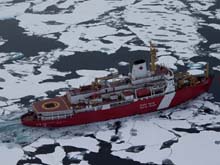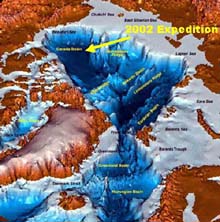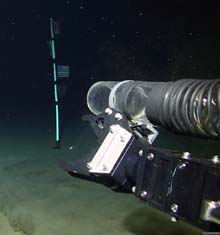
The 392-ft. CCGS Louis St. Laurent powers easily through broken ice. This photo was taken from the Louis’ helicopter. (Photo courtesy Emory Kristof, National Geographic Society.) Click image for larger view.

The 24-day Arctic Expedition in the summer of 2002 focused on the deep and poorly understood Canada Basin. Click image for larger view.

Just released by the ROV’s manipulator arm, a mini-flagpole rests at the bottom of the Canada Basin. Symbolizing the cooperation that made this multinational expedition a success, the flags of all participating nations (Canada, China, Japan and the United States) hang from the pole. (Photo courtesy Emory Kristof, National Geographic Society). Click image for larger view.
Arctic Exploration:
Highlights and Mission Summaries
August 14 - September 8, 2002
Arctic Exploration: Introduction
Kathleen Crane,
Mission Coordinator
Arctic Research Office, NOAA
On the Arctic 2002 expedition, 46 scientists from the United States, Canada, Japan and China gathered by ship and charter aircraft at the little Alaskan town of Kugluktuk. The expedition on board the Canadian Coast Guard icebreaker Louis St. Laurent lasted 24 days and covered 2,440 nautical miles, mostly through ice- covered waters. Dr. Fiona McLaughlin, of the Institute of Ocean Sciences in Sidney, British Columbia, served as the expedition's chief scientist. All of the NOAA-funded ocean exploration work was coordinated to complement the physical and chemical oceanography research led by the Candians and Japanese. The expedition's objectives were to:
- take a first census of life in the Canada Basin from the sea ice down to the sea floor, and
- measure the physical and geochemical properties in different regions of the Canada Basin, the last basin of the Arctic Ocean to receive warmer and fresher waters of Atlantic origin.
As we settle back into our daily routines at home and work, we finally have the chance to reflect on the preliminary results of our mission. Personally, I am amazed at how many operations we were able to carry out on board. Considering that many of our tools were newly developed and still needed assembly when the ship left port in early August, the teams persevered under great uncertainty and successfully deployed a remotely operated vehicle (ROV) to the bottom of the Canada basin.
One of the positive aspects of an expedition in which such a diverse array of science was conducted is that it addresses the need for regional ecosystem studies. Very little had been known about the biota in the Canada Basin prior to the expedition, and we gleaned information of the entire water column from several critical areas: the eastern and western sides of the top of the Northwind Ridge, and in the Northwind Basin. We focused on studies of the life in the ice, under the ice, in the water column and on the sea floor. Our subjects ranged from macro to micro fauna and flora.
These summaries are available:
Sign up for the Ocean Explorer E-mail Update List.

































